
Posted on 12/17/2011 5:03:31 AM PST by Homer_J_Simpson


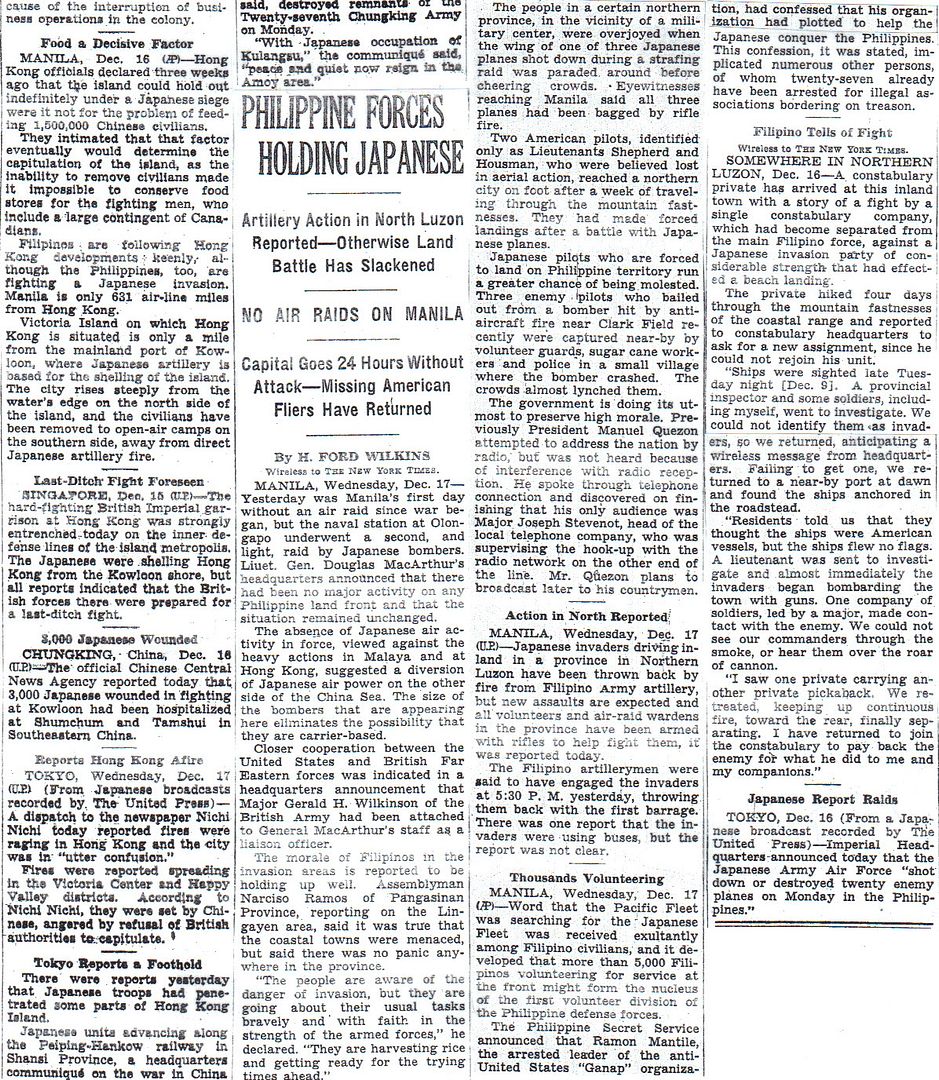
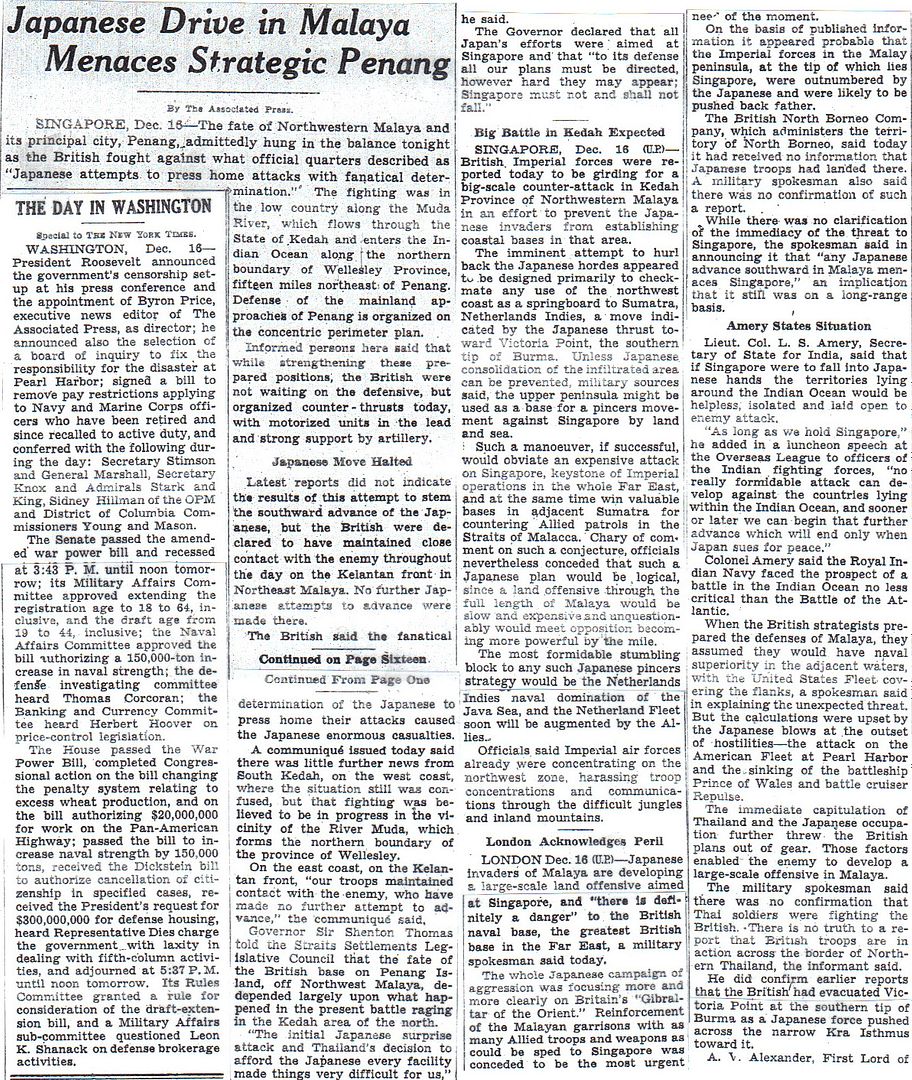


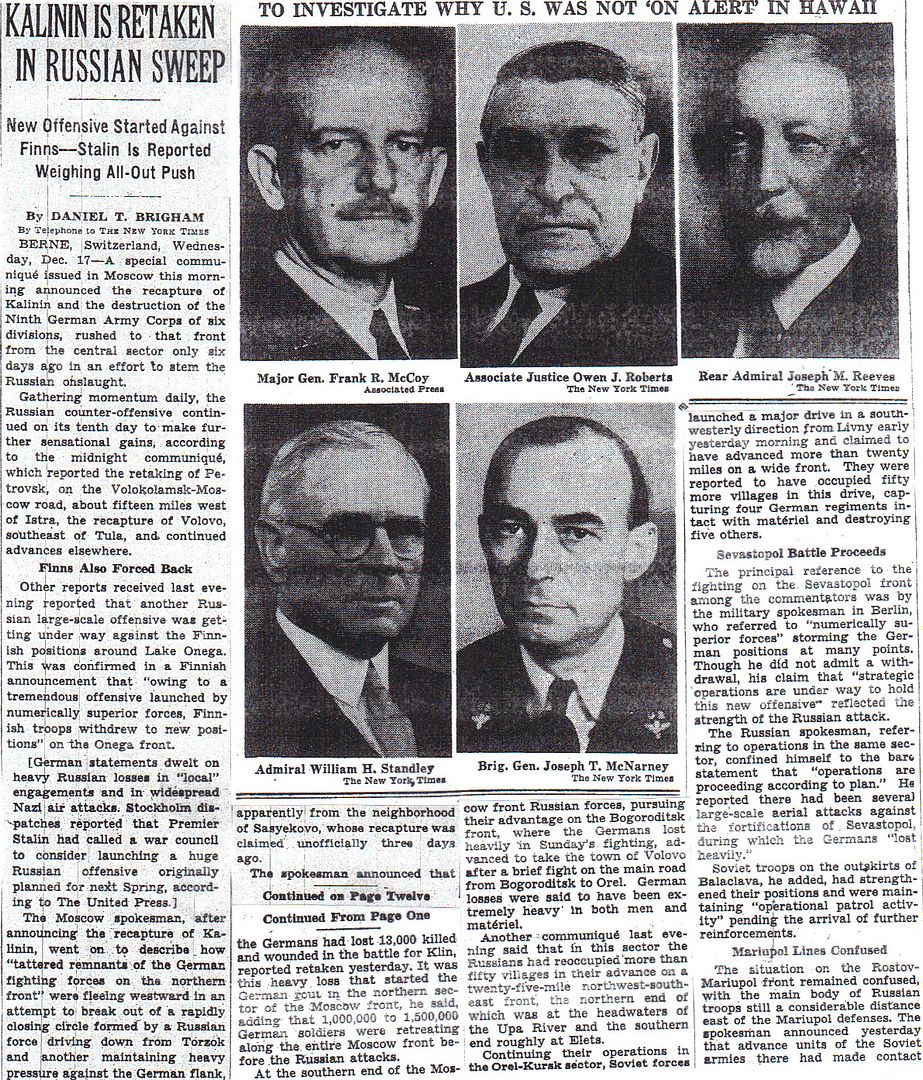
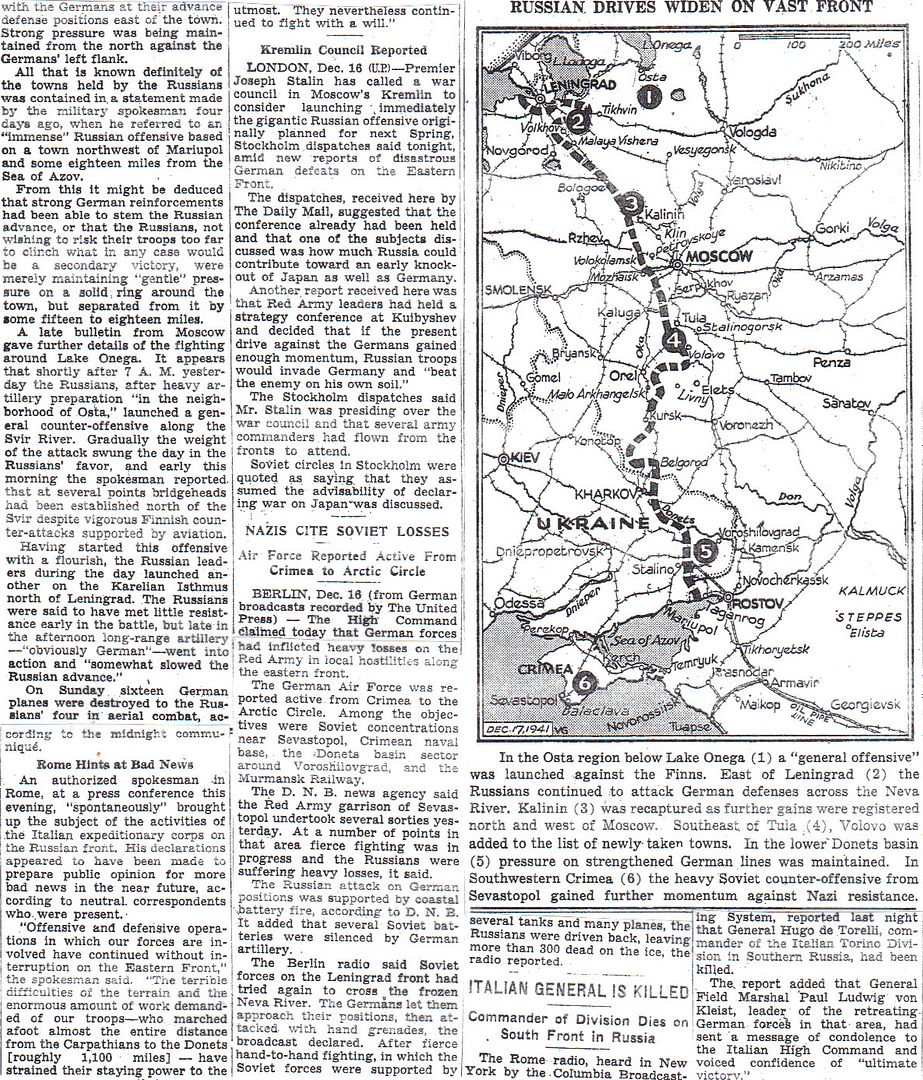
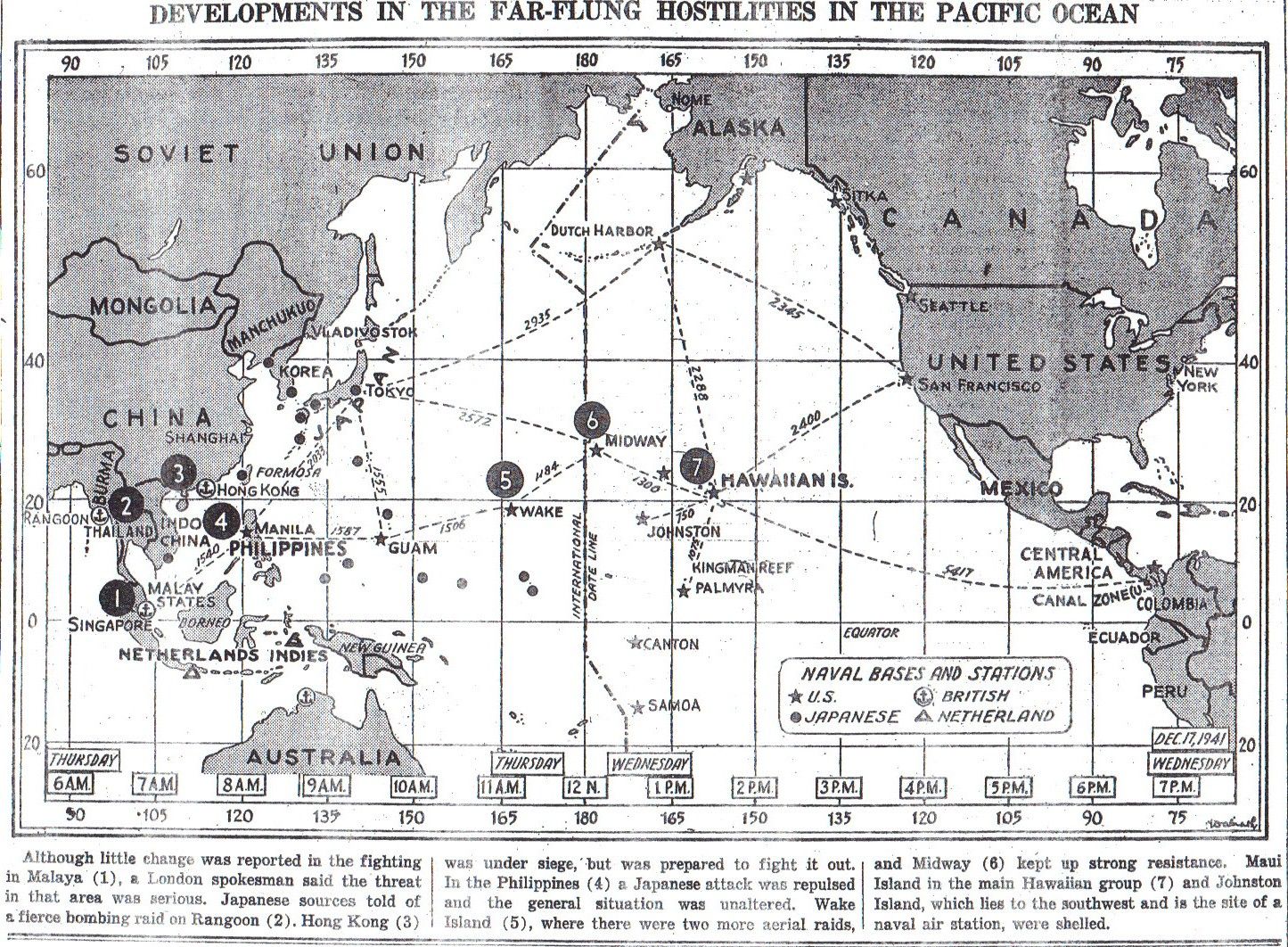

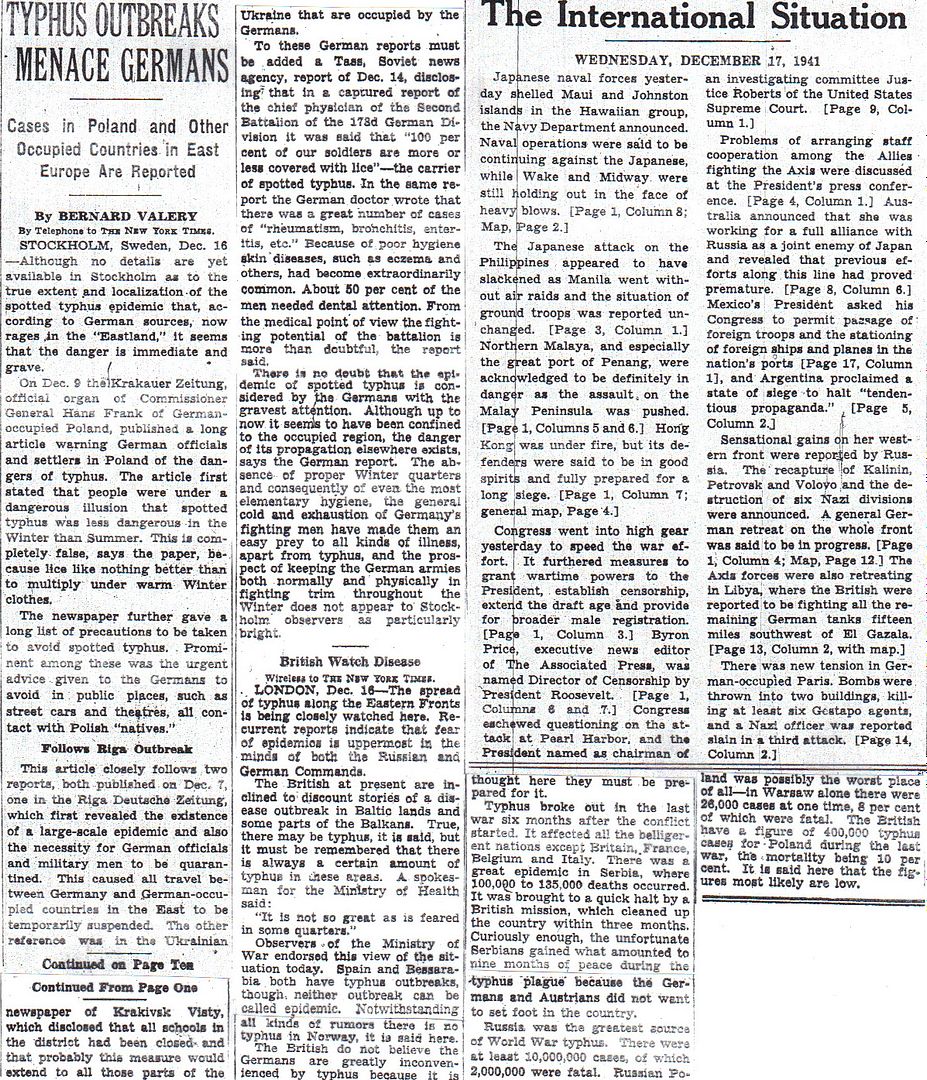
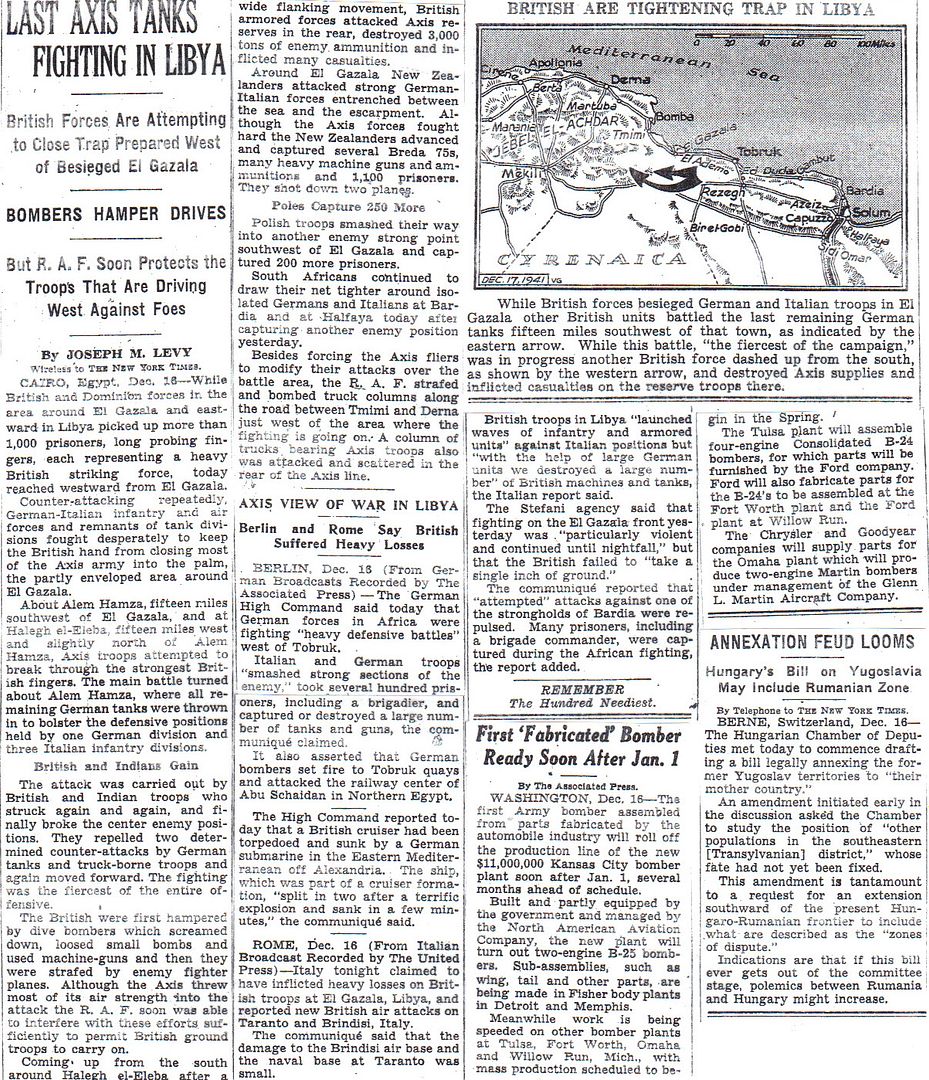
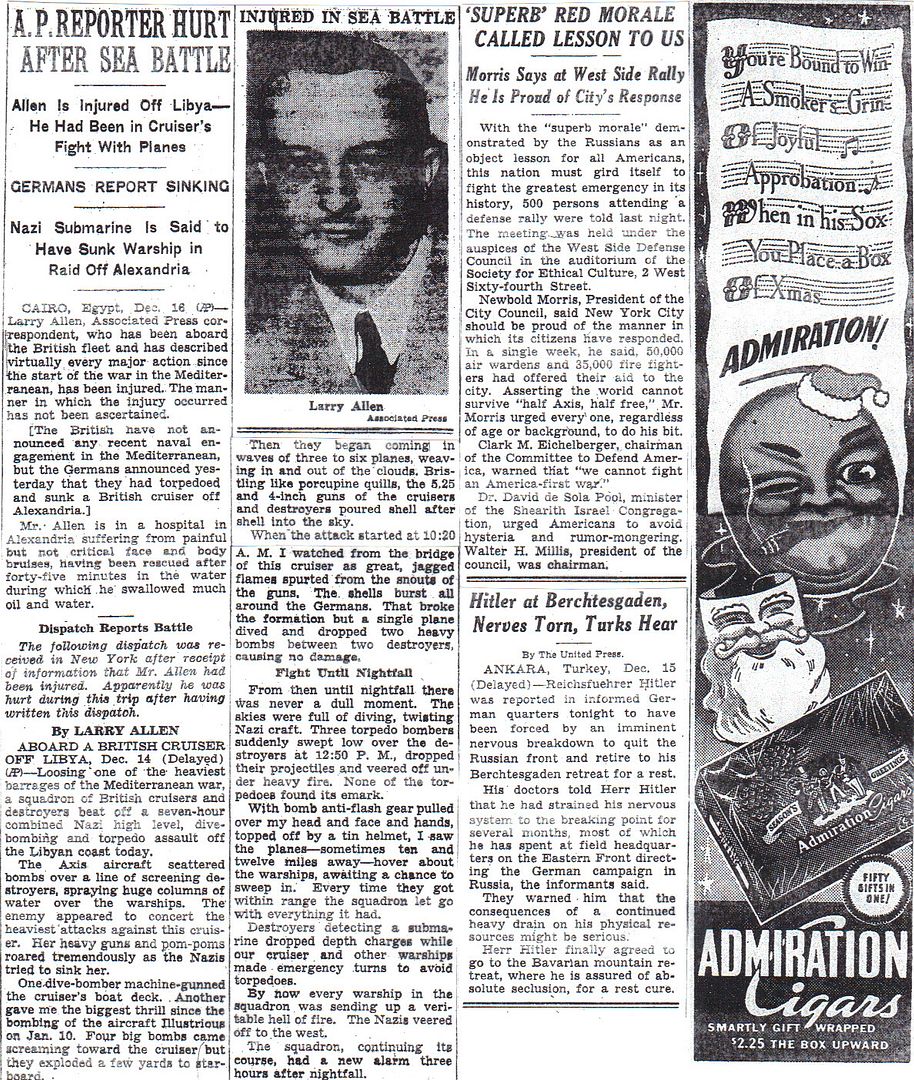
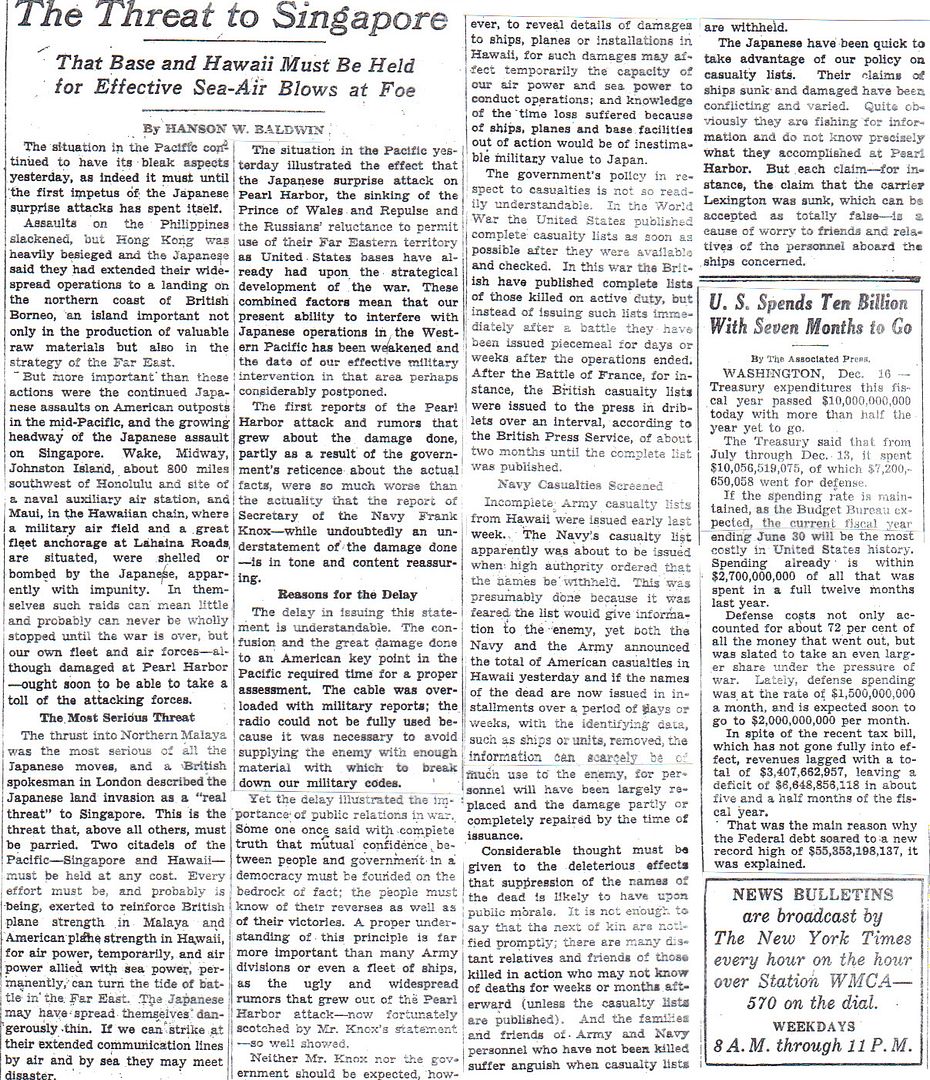

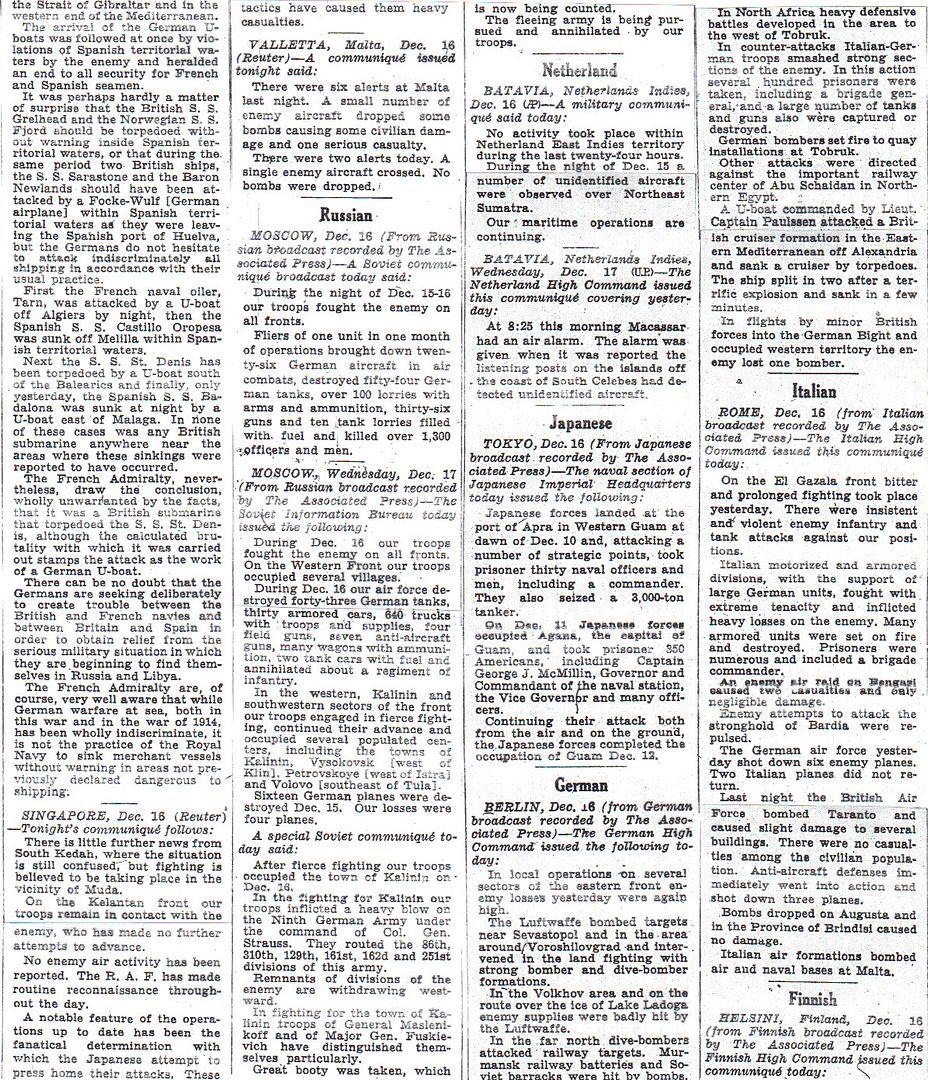

http://www.onwar.com/chrono/1941/dec41/f17dec41.htm
Germans attacking Sevastopol
Wednesday, December 17, 1941 www.onwar.com
On the Eastern Front... In the Crimea, German attacks by 54th Corps begin against the city of Sevastopol despite continuing Soviet offensives in other areas.
In Malaya... The British withdraw from Gurun. Japanese begin landing the Imperial Guard Division
In the Mediterranean... British Force K from Malta and Force B from Alexandria join in convoy. Battle of Sirte Forces from the British convoy from Alexandria to Malta meet the Italian convoy to Egypt. They engage but the focus of the escorts is to ensure their convoy’s safety and the battle is indecisive.
In the North Atlantic... British cruiser Dunedin is sunk by a U-boat.
From Washington... Admiral Nimitz to appointed to the command of the Pacific Fleet, replacing Admiral Kimmel who resigned as the result of Pearl Harbor.
http://homepage.ntlworld.com/andrew.etherington/month/thismonth/17.htm
December 17th, 1941
UNITED KINGDOM: Sloop HMS Lapwing laid down. (Dave Shirlaw)
GERMANY:
U-335 commissioned.
U-645 laid down. (Dave Shirlaw)
ALBANIA: Albania declares war on the U.S. (Jack McKillop)
U.S.S.R.: In the Crimea, German attacks by 54th Corps of the German Army Group South begin against the city of Sevastopol despite continuing Soviet offensives in other areas. (Jack McKillop)
Soviet submarine M-59 sunk by depth charge by Romanian destroyer Ferdinand. (Dave Shirlaw)
MEDITERRANEAN SEA: During the day British naval Force K joins Admiral Vian’s Force B from Alexandria. Tonight this British force meets the Italian convoy escort which sailed yesterday. The action, the First Battle of Sirte, is spent protecting the convoy and is therefore indecisive, and a strategic victory for the Italians.
In addition Force K (three light cruisers plus destroyers), the raiding force which had been involved in many of the most spectacular successes against the Italian convoys, ran into a newly-laid Italian minefield right after the First Battle of Sirte, with the result that the cruiser HMS NEPTUNE hit four mines and was sunk with only one survivor, HMS AURORA was heavily damaged and HMS PENELOPE lightly damaged. The destroyer HMS KANDAHAR was sunk but her crew was taken off first. (Mike Yaklich and Ric Pelvin)
HONG KONG: The Japanese control the north side of Hong Kong harbour, the British Hong Kong island. After a week of air bombardment, Japanese General Saito sends a captured British civilian woman (and her two dogs) across the harbour to demand surrender from British Governor Sir Mark Young. Sir Mark himself “declines absolutely to enter into negotiations for the surrender of Hong Kong.” (Jack McKillop)
MALAYA: Hard fighting continues on the Grik road. A weak defence detachment is reinforced but falls back under pressure of the superior enemy forces. The Indian 12th Brig Group is ordered to Kuala Kangsar. Lieutenant General Sir Arthur E. Percival gives the Indian 3 Corps permission to withdraw to the Perak River line if necessary. The Perak Flotilla is formed to prevent the enemy from landing on the west coast between Knan and Bernam Rivers. (Jack McKillop)
NETHERLANDS EAST INDIES: The Australian “Gull Force” lands on Ambon Island. This force is comprised of the 2/21st Battalion of the 23rd Brigade, “C” Troop of the 18th Antitank Battery, a section of 2/11th Field Company and various other support units. The force had been transported from Darwin, Northern Territory, Australia, to Ambon in three Dutch merchant ships escorted by an RAN light cruiser and corvette. (Jack McKillop)
BORNEO: Dutch reconnaissance aircraft from Singkawang, Borneo, fly reconnaissance flights over the Japanese invasion fleet. They attack the ships but do not damage any. (Jack McKillop)
COMMONWEALTH OF THE PHILIPPINES: The Japanese Legaspi force, advancing northwest on Luzon along Route 1 toward Naga, makes its first contact with Filipino forces near Ragay. (Jack McKillop)
AUSTRALIA: A plan is drawn up for using Australia as an Allied supply base under command of Major General George H. Brett, USA. (Jack McKillop)
B-17 Flying Fortresses, evacuating the Philippine Islands, begin arriving at Batchelor Field near Darwin, Northern Territory. Captain Floyd J Pell arrives in Australia to begin arrangements for the use of Australian facilities by the Far East Air Force. (Jack McKillop)
Minesweeper HMAS Katoomba commissioned. (Dave Shirlaw)
TERRITORY OF HAWAII: In a command shake up, Admiral Husband E. Kimmel is replaced by Admiral Chester W. Nimitz as Commander-in Chief, Pacific Fleet; Lieutenant General Walter C. Short, Commanding General Hawaiian Department, is replaced by Lieutenant General Delos C. Emmons; and Major General Frederick L. Martin, Commanding General Hawaiian Air Force, is replaced by Brigadier General Clarence L. Tinker. Admiral William Pye becomes acting commander until Nimitz’s arrival. Rear Admiral Husband E. Kimmel was relieved of his command of the US Pacific Fleet as part of a shake-up of officers in the wake of the Pearl Harbor disaster. Admiral Kimmel had enjoyed a successful military career, beginning in 1915 as an aide to the Assistant Secretary of the Navy, Franklin Delano Roosevelt. He served admirably on battleships in World War I, winning command of several in the interwar period. At the outbreak of World War II, Kimmel had already attained the rank of rear admiral and was commanding the cruiser forces at Pearl Harbor. In January 1941, he was promoted to commander of the Pacific Fleet, replacing James Richardson, who FDR relieved of duty after Richardson objected to basing the fleet at Pearl Harbor. (Jack McKillop and Dave Shirlaw)
A Yokosuka E14Y1, Navy Type 0 Small Reconnaissance Seaplane (later assigned the code name GLEN by the Allies) makes it operational debut when the submarine HIJMS I-7 launches its aircraft for a dawn reconnaissance over Pearl Harbor to determine the damage caused by the attack of 7 December. (Jack McKillop)
MIDWAY ISLAND: Seventeen SB2U-3 Vindicators of Marine Scout Bombing Squadron Two Hundred Thirty One (VMSB-231) complete a record 9 hour and 45 minute flight from Hawaii to Midway, bolstering U.S. positions there. The aircraft were led by a plane-guarding PBY-4 Catalina of Patrol Squadron Twenty One (VP 21) (no ships are available to plane-guard the flight) on this longest over-water massed flight (1,137 miles or 1,830 kilometres) by single-engine aircraft. VMSB-231 was the same squadron that was en route to Midway on 7 December aboard the aircraft carrier USS Lexington (CV-2) when reports of the attack on Pearl Harbor forced the carrier to turn back short of her goal. (Jack McKillop)
CANADA: Minesweepers HMCS Mahone and Chedabucto arrived Halifax from Esquimalt. (Dave Shirlaw)
U.S.A.: Light cruiser USS Columbia launched.
Large cruiser USS Alaska laid down. (Dave Shirlaw)
ATLANTIC OCEAN: USS McCalla (DD-253), was commissioned as HMS Stanley (I-73) on 23 Oct. 1940, as part of the destroyers-for-bases deal. Today she is part of the escort to convoy HG76 from Gibraltar. Stanley and accompanying vessels escort destroyers HMS EXMOOR and HMS BLANKNEY, the corvette HMS PENTSTEMON and the sloop HMS STORK (commanded by Lt-Cdr F. J. (Johnnie) Walker) sink U-131 northeast of Madeira. They will sink U-434 tomorrow. (Ron Babuka and Alex Gordon)
U-131 is sunk in position 34.12N, 13.35W, by depth charges and gunfire from escort destroyers HMS Exmoor and Blankney, destroyer HMS Stanley, corvette HMS Pentstemon and sloop HMS Stork and by machine-gun fire from a Martlet aircraft (802 Sqn) of the British escort carrier HMS Audacity. 47 survivors (No casualties). U-131 had shot down a Martlet aircraft at the start of the action; the first aircraft shot down by a U-boat in the war. Known as the “Martlet” in the RN, this was then the USN’s top-of-the-line carrier fighter, the Grumman F4F, in American service called the “Wildcat”. Prior to actual US entry into WWII, many F4Fs rolled out of the “Iron Works”, as Grumman’s plant was known to happy USN aviators, with RN roundels already painted on prior to test flights and shipment. (Dave Shirlaw, Ron Babuka and Alex Gordon)
Interesting about the Jan. 24, 1941 letter quoted from Adm. Yamamoto. I had always seen him described as relatively non-imperialistic, non-aggressive, liking the USA from his time here etc., but this sounds extremely bellicose and aggressive:
“Any time war breaks out between Japan and the United States I will not be content merely to capture Guam and the Philippines and occupy Hawaii and San Francisco I am looking forward to dictating peace to the United States in the White House at Washington.”
— Admiral Isoroku Yamamato, Jan. 24, 1941 —
If that’s the ‘real’ Yamamoto then I’m really glad we shot his plane down near Rabaul.....
(actually I’d be glad anyway but this letter makes it sweeter)
re: the various conspiracy theorists, Cordell Hull’s formal “war warning” to all govt depts, Nov. 27, was ample warning to Kimmel and Short to be prepared for anything. It was not for civilian officials to spell out every possibility of attack etc. Of course hindsight is easy but the relevant information was in the hands of Kimmel and Short, they knew Japan had made surprise attacks in the past, the Brits at Taranto had showed what aerial attacks on a fleet in port could do, etc. No one hid the relevant info from Short and Kimmel, they had it and did not act sufficiently upon what they knew.
The way I understand it is Yamamoto’s letter is being taken way out of context and possibly edited to change the meaning. He knew what the result would be if war with the U.S. was prolonged. He was saying in his letter that he didn’t believe a strike at Pearl Harbor would knock us out of the war at one punch, but that to achieve victory it would be necessary to invade the mainland and actually enter Washington. Yamamoto had lived in the U.S. and knew the absurdity of such a scenario. So what he said in the letter was heavily ironic.
I know others can confirm or correct my recollection on this.
From what I remember, the message from Wake Island, “Send us more Japs” never actually took place. It was just a rumor that started in Hawaii. I sure like it though and I’m sure the American public at this time really did too.
I’m really just splitting hairs, but Yamamoto was shot down on the southern end of Bougainville about 300 miles away from Rabaul on New Britain.
Homer, I believe you are correct, the letter has been taken way out of context; in fact, it’s so out of context as to be libelous, should it ever have come to that.
Yamamoto’s original statement was to the effect that taking on the United States was going to be a formidable task, and that the Americans would not quit fighting until the Japanese dictated peace terms in the White House, an eventuality he did not believe would ever happen. In other words, he counseled against war with America.
This will not be the last time the Times distorts something from the Japanese. The war will end with an incomplete translation of the word “mokusatsu.”
"Not until Hitler declared war on the United States did these office workers at the America First headquarters remove isolationist material.
Formed in July 1940, the America First Committee was the major isolationist group of the time.
Infiltrated by the Nazis and determined to prevent American entanglements in Europe, America First had ties with congressional isolationists and antisemites.
The committee did not officially adopt antisemitism, although its membership list contained such prominent antisemites as Henry and Clara Ford, Charles Coughlin, Gerald Smith, Gerald Winrod, William Pelley, and American Nazi leader Fritz Kuhn."
Well yes, his plane took off from Rabaul but was 300 miles away on an inspection tour.... I was merely speaking broadly in the strategic sense that within “600 miles” would be “near” but thank you for the clarification.
I read up a bit on that letter (via our Wiki friend), and it seems it was Japanese militarists who distorted Y’s message by omitting the sentence that followed. They circulated the truncated quotation to make it seem as though Y. was boasting about what the IJN could do and would do, eliminating Y’s caution which followed.
He was trying to caution the ultra-militarists that they did not grasp the real implications of going to war with America, that it would require a total defeat of America and not some one-off local victory.
No one in Washington admitted after-wards that they suspected a Japanese attack on Hawaii -- yes, the Philippines and SE Asia, but not Hawaii.
""November 27, 1941 - This despatch is to be considered a war warning."Negotiations with Japan looking toward stabilization of conditions in the Pacific have ceased and an aggressive move by Japan is expected within the next few days.
"The number and equipment of Japanese troops and the organization of the naval task forces indicates an amphibious expedition against either the Philippines Thai or Kra Peninsula or possibly Borneo.
Execute an appropriate defensive deployment preparatory to carrying out the tasks assigned in WPL 46.
Inform district and army authorities."
Both Kimmel and Short later claimed that if they had been better warned, they would have been better prepared.
But MacArthur in the Philippines, who was better warned, was virtually no better prepared.
And where Kimmel and Short were relieved and disgraced, MacArthur soon became a national hero.
So how do you figure that?
Here is one particularly interesting account:
"Probably the closest that anyone came to considering an attack against Oahu was Admiral Husband Kimmel.
On November 27, a large meeting took place in which Kimmel and his staff met with Lt. General Walter Short, the senior US Army commander in Hawaii.
During the meeting, the army's plan to assume command of the defense of Wake and Midway islands was viewed with concern by Lt. Colonel James Mollison, primarily because such a defense would drain valuable aircraft away from Oahu.To this Kimmel responded "Why are you so worried about this? Do you think we are in danger of attack?"
To which Mollison replied "The Japanese have such a capability."
"Capability, yes, but possibility?" asked Kimmel.
Immediately he asked the fleet war plans officer, Captain Charles McMorris, "What do you think about the prospects of a Japanese air attack?"McMorris replied "None, absolutely none."
Still, Kimmel may not have been completely convinced.
He turned down the prospective move of half the island's army aircraft, keeping them on Oahu just in case."
But again, the most intriguing question is: even had US forces been on higher alert, would there have been fewer ships sunk or men killed?
Yeah, like I said, it’s just splitting hairs really. I think its because of the fact that the crash site is on a different island than Rabaul on New Britain that it read funny to me.
Disclaimer: Opinions posted on Free Republic are those of the individual posters and do not necessarily represent the opinion of Free Republic or its management. All materials posted herein are protected by copyright law and the exemption for fair use of copyrighted works.